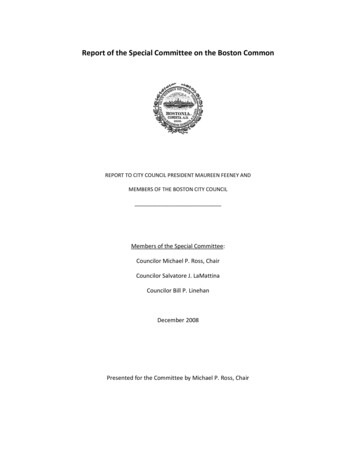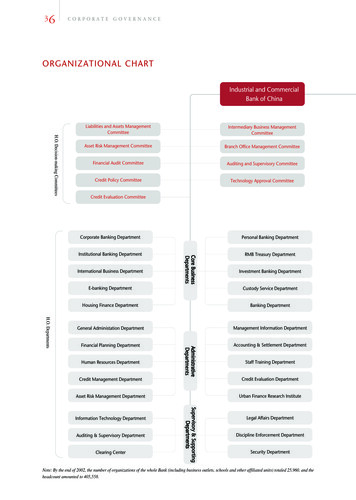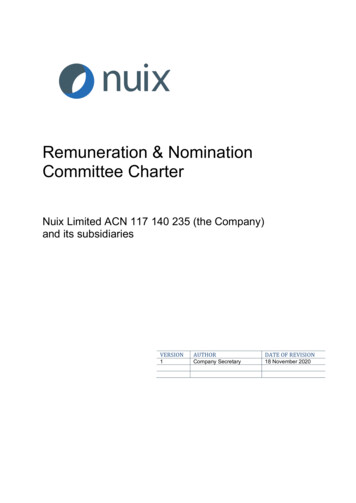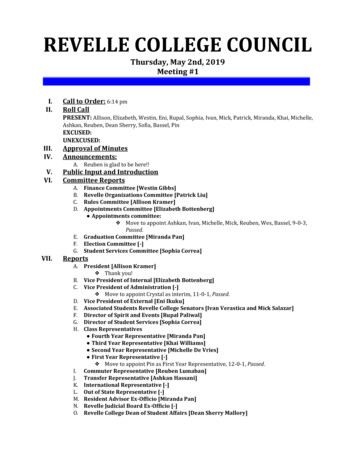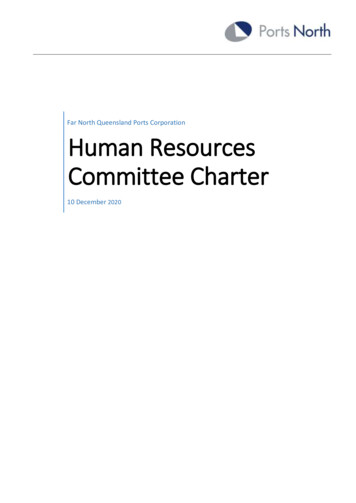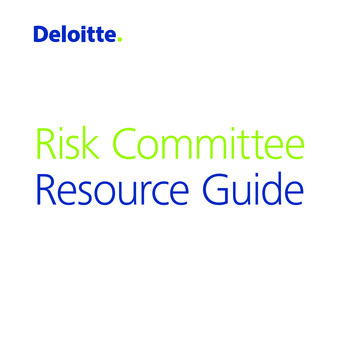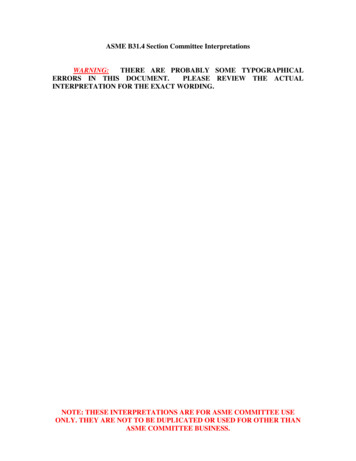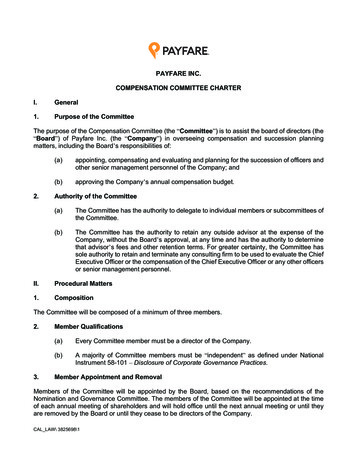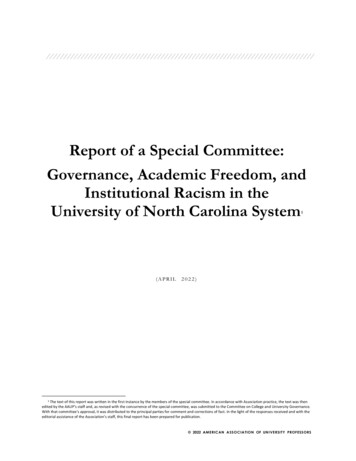
Transcription
///////////////////////////Report of a Special Committee:Governance, Academic Freedom, andInstitutional Racism in theUniversity of North Carolina System1(APRIL2022)1 The text of this report was written in the first instance by the members of the special committee. In accordance with Association practice, the text was thenedited by the AAUP’s staff and, as revised with the concurrence of the special committee, was submitted to the Committee on College and University Governance.With that committee’s approval, it was distributed to the principal parties for comment and corrections of fact. In the light of the responses received and with theeditorial assistance of the Association’s staff, this final report has been prepared for publication. 2022 AM ERICAN A SSOCIATION OF UNI VERSIT Y PROFESSORS
Special Committee Report: Governance, Academic Freedom, andInstitutional Racism in the University of North Carolina SystemI. INTRODUCTION . 1II. THE UNIVERSITY OF NORTH CAROLINA SYSTEM . 1III. ACADEMIC GOVERNANCE AT UNC . 5A. Appalachian State University: Provost Appointment .6B. Fayetteville State University: Chancellor Appointment .7C. UNC–Chapel Hill: Provost Appointment .8D. East Carolina and Western Carolina Universities.9E. COVID-19 and Faculty Governance .9F. Conclusion . 11IV. ACADEMIC FREEDOM . 12A. Teaching . 13B. Policy Centers . 13C. UNC Press . 17V. INSTITUTIONAL RACISM . 19A. Racial Climate. 201. Silent Sam .202. Professor Nikole Hannah-Jones .24B. Power, Leadership, and Institutional Inequities . 28C. Retention of Faculty Members of Color . 32D. Conclusion . 33VI. THE FUTURE OF UNC. 34
Special Committee Report: Governance, Academic Freedom, andInstitutional Racism in the University of North Carolina SystemI. IntroductionThe University of North Carolina system is introuble, and not the kind of trouble that recordenrollments or good rankings can fix. It is the kindof trouble that festers and spreads. As one formerlong-time faculty member and administrator put it,“If you begin to rot in one area, it will quickly haveadverse effects elsewhere.”The charge of the undersigned special committeewas to discover the extent and effects of this troublewithin the UNC system. While our report wasoriginally intended to focus on UNC–Chapel Hill asthe flagship campus, the committee examined eventsacross the entire system. AAUP special committeesdelve into a range of issues and analyze patterns ofdepartures from AAUP-recommended standardsthat affect multiple institutions or the highereducation community at large. The scope of a specialcommittee’s report is therefore more expansive thanthe scope of a typical AAUP investigatingcommittee. Those committees are charged withreporting their findings on alleged violations ofspecific AAUP-supported principles and standardsrelating either to academic freedom and tenure or toacademic governance.The events that prompted the creation of thisspecial committee are numerous and welldocumented. Indeed, new events of concern in theUNC system continued to be reported in the medialong after the committee had submitted its draftreport. In keeping with the committee’s charge, wehave organized our report around three mainthemes: violations of standards of sharedgovernance, threats to academic freedom, andinstitutional racism. The cases discussed in eachsection are illustrative rather than exhaustive.The special committee conducted interviews viaZoom from early November through mid-December2021 with more than fifty individuals across theUNC system, including faculty members, current andformer administrators, two former UNC–ChapelHill trustees, and members of the systemwide RacialEquity Task Force. One faculty member provided uswith a lengthy written report of events at UNC;others sent the committee relevant documents andmedia accounts not available to us elsewhere.UNC system president Peter Hans, board ofgovernors chair Randall Ramsey, UNC–Chapel Hillchancellor Kevin Guskiewicz, and UNC–Chapel Hillboard of trustees chair David Boliek declined to beinterviewed. Dr. Kimberly van Noort, senior vicepresident for academic affairs and chief academicofficer for the UNC system, responded on behalf ofChair Ramsey by commending to our attention thesystemwide Racial Equity Task Force and itsreports. 2 Vice President van Noort emphasized thatthe system’s 2020 Racial Equity Task Force hadsurveyed “more than 2,000 faculty, staff, andstudents across the system, including at UNC–Chapel Hill” and made six recommendations withtwenty-eight “action steps,” fifteen of which wereconsidered “critical to the success of therecommendations.” In this committee’s judgment,the recommendations and action steps delineated bythe Racial Equity Task Force Report areconstructive, and we were encouraged by facultymembers’ accounts of progress in implementingthem. At the same time, as our report indicates,faculty members across the system do not believethe work of the task force has yet led to anysubstantial improvement in campus climate relatingto race or yielded any noticeable reduction in racialinequity. Indeed, our interviewees barely mentionedthe task force report on racial equity when wequestioned them about these matters, suggestingtheir sense of its irrelevance.2 See “UNC System Racial Equity Task Force Final Report,” December 16,2020, uity-task-force-final-report.pdf. InJuly 2021, the system office released an updated report, which claimed someprogress in addressing the 2020 report’s recommendations (“UNC SystemOffice Racial Equity Initiative Update tyinitiativeupdatereport-21july2021.pdf).3 Joe Killian, “Author Geeta Kapur Discusses Her New Book Detailing theHistory and Legacy of Racism at UNC,” NC Policy Watch, August 9, I. The University of North Carolina SystemThe University of North Carolina was established bycharter of the North Carolina General Assembly in1789 and built by enslaved labor. Founder GeneralWilliam Davie, an owner of enslaved persons, laidthe university’s cornerstone on October 12, 1789,just days after having “sold a young, enslaved girlnamed Dinah and bought an enslaved man namedJoe.” 3 It was the first public university in the UnitedStates, admitting its first class in 1795, and ChapelHill was the location of its only campus. Like mostother Southern colleges and universities, the1
Special Committee Report: Governance, Academic Freedom, andInstitutional Racism in the University of North Carolina SystemUniversity of North Carolina excluded Blackstudents for most of its history, permitting them toattend only in the last seventy years.By 1877, the General Assembly had begunsponsoring additional institutions of highereducation, including five historically Blackinstitutions. In 1931, the assembly redefined theuniversity to include three state-supportedinstitutions: the University of North Carolina atChapel Hill, North Carolina State College (nowNorth Carolina State University), and the Woman’sCollege of the University of North Carolina (now theUniversity of North Carolina at Greensboro).In 1969, three additional public institutions werebrought into the UNC system: the University ofNorth Carolina at Charlotte, the University of NorthCarolina at Asheville, and the University of NorthCarolina at Wilmington. By 1971, the state’s tenremaining public four-year institutions were alsoincorporated into the system: Appalachian StateUniversity, East Carolina University, Elizabeth CityState University, Fayetteville State University, NorthCarolina Agricultural and Technical State University,North Carolina Central University, the NorthCarolina School of the Arts (now the University ofNorth Carolina School of the Arts), Pembroke StateUniversity (now the University of North Carolina atPembroke), Western Carolina University, andWinston-Salem State University. In 2007, the NorthCarolina School of Science and Mathematics (asecondary school) became a constituent institution.Five of the system’s constituent institutions arehistorically Black colleges and universities (HBCUs):Fayetteville State (established in 1867), ElizabethCity State (1891), North Carolina Agricultural andTechnical State (1891), Winston-Salem State (1892),and North Carolina Central (1910). And one, UNCPembroke, is the only state-designated historicallyAmerican Indian university. In September 2021, theUNC system reported its fourth straight year ofrecord enrollment, with more than 244,000 studentsenrolled at its seventeen institutions.The system is overseen by a board of governors,which, according to state law, has responsibility forthe planning, development, and overall governanceof the system. The system board currently hastwenty-four voting members, who are elected by theGeneral Assembly and who select the systempresident. 4 Mr. Hans has served in that capacity since2020, following two years as president of the NorthCarolina Community College System. The legislatureelected him to the UNC board of governors in 2003,2007, and 2011, and he was chair from 2012 to 2014.Each institution within the system is led by achancellor and overseen by a board of trustees. Thesystemwide board of governors selects thechancellors and appoints eight of each campus’sthirteen trustees, with four of the remaining trusteesappointed by the General Assembly and the studentgovernment president serving ex officio. 5The ensuing sections of this report are bestunderstood against the background of politicalinterference that has recently characterized the entireUNC system. We found a broad consensus amongthose we interviewed that 2010 marked the start of anew era in the political and administrative life of thesystem. In November of that year, Republicans wonmajorities in both houses of the General Assembly,gaining unified control of the state legislature for thefirst time in more than a century. Many in themajority believed that the system, governed fordecades by Democratic-leaning appointees, hadbecome dominated by what they considered out-ofcontrol liberalism to the detriment of conservativeviewpoints. They saw the UNC board of governors,with its broad agenda-setting powers, as the key totransforming the university system. 6While board appointments have always beenpolitical to a certain degree in North Carolina (andelsewhere), the individuals we interviewed told usthat prior to 2010 the General Assembly had usually4 See Will Melfi and Rachel Crumpler, “Who Are the Voting Members on theUNC Board of Governors?,” Daily Tar Heel, April 16, unc-board-of-governors.5 See nance/board-ofgovernors.6 See Nick Anderson and Susan Svrluga, “Inside the Dramas at UNC–ChapelHill: Boards, Partisan Politics, and the Flagship,” Washington Post, July 29,2021, 9/unc-boardleadership-politics-republicans.But the UNC board of governors is hardly unique among politicallyappointed governing boards in seeking to advance a conversative agenda inhigher education. See Peter Schmidt, “Colleges Draw Hard Lines against Calls toRestrict Speech,” Chronicle of Higher Education, February 29, aw-hard-lines-against-calls-torestrict-speech; Jack Stripling, “How Far Will Higher Ed’s Culture Wars Go?South Dakota Is Running Previews,” Chronicle of Higher Education, March 17,2020, views; Peter Schmidt, “Wisconsin’s TenureBattle Shifts to Campuses,” Chronicle of Higher Education, March 18, 2016;Lindsay Ellis, Jack Stripling, and Dan Bauman, “The New Order: How theNation’s Partisan Divisions Consumed Public-College Boards and WarpedHigher Education,” Chronicle of Higher Education, September 25, er.2
Special Committee Report: Governance, Academic Freedom, andInstitutional Racism in the University of North Carolina Systemsought to make appointments of political moderatesand to maintain a degree of partisan balance on theuniversity boards it oversaw. After 2010, thosepractices changed. Appointees were now moreuniformly Republican, more interested in thepolitical ideologies of campus actors, and lessexperienced with higher education than theirpredecessors. Several were lobbyists. If there hadbeen any doubt that the UNC system was nowsubject to a new regime of partisan control, it wasput to rest in late 2016, when the outgoingRepublican governor signed legislation stripping hisDemocratic successor of the power to makeappointments to campus-level boards of trustees. 7Prior to that change, the governor had beenresponsible for appointing four of thirteen memberson those boards. The Republican-sponsoredlegislation transferred the governor’s appointmentpower to the legislature, which has remained inRepublican hands since that time and now enjoysnear-total control over appointments to campuslevel boards of trustees through a combination ofdirect appointment power and indirect influencethrough the board of governors. The UNC systemboard of governors is the only statewide governingboard solely appointed by the legislature withoutinput from the governor. 8The environment for shared governance andacademic freedom in the UNC system must beunderstood against this backdrop of pervasive andovertly partisan political control. When the board ofgovernors began wading into campus-level matters,it often did so in thinly veiled defense of thelegislative leadership that had appointed itsmembers. This approach seems to have beenespecially evident in the systemwide review ofcampus centers that began in 2014 at the legislature’sbehest and culminated in the closure of three ofthose centers, including two headed by facultymembers who had been vocal critics of stateleadership: the Center for Work, Poverty, andOpportunity at the UNC–Chapel Hill School ofLaw; and the Institute for Civic Engagement andSocial Change at North Carolina Central. The detailsof these closures are discussed later in this report.Here we will only note that, while the ostensiblepurpose of the review was to find cost savings,shuttering these centers could hardly have eased thesystemwide budget since their funding came eitherlargely or exclusively from private sources. Theboard bypassed all customary channels for assessingthe academic merits of these centers, includingfaculty review, and did not even pretend that thedecisions to close them were based on academicconsiderations. Rather, the legislature, through theboard of governors, was now explicitly meddling inacademic matters for expressly political reasons.This pattern continued in 2017, when the board ofgovernors voted to bar campus centers fromengaging in litigation. 9 Though the policy technicallyapplied to centers across the system, its clear targetwas the Center for Civil Rights, another UNC–Chapel Hill law school center. Many interpreted thisaction as intended to squelch legal activity of whichthe board of governors and the legislaturedisapproved. As will be shown in greater detail laterin this report, in pursuing the material andideological goals of its own members and those whohad appointed them, the board acted in egregiousviolation of its appropriate role and responsibility,thereby dealing a significant blow to the educationaland professional development opportunities of UNClaw students.The board of governors veered yet further awayfrom AAUP-supported governance standards in fall2020 when it approved a new and highly unorthodox7 Rick Seltzer, “Trustee Appointment Takes Political Turn,” Inside Higher Ed,December 19, nts-away-north-carolina-governor.“The removal of the governor’s ability to appoint four members of theBoard of Trustees was alarming,” said former Chapel Hill chancellor JamesMoeser. “That was the first sign that the leaders of the General Assembly hadvery partisan objectives in mind” (Ned Barnett, “A Right Turn at UNC: Has aDecade of Republican Maneuvering Really Harmed the UNC System?” RaleighNews & Observer, February 7, .html).8 Models of higher education governance have varied greatly from state tostate and over time. Depending on one’s definitions, seventeen states currentlyhave a model in which a single governing body oversees all or almost all thebaccalaureate institutions in the state. Several other states, such as Californiaand Connecticut, have one governing body for the “University of” system andanother for the “State University” system. The general tendency over time hasbeen toward concentration of governance in fewer local boards of trustees, buta great diversity of models remains across the country.The typical arrangement for the seventeen statewide systems mentionedabove is that members of each statewide governing body are appointed by thegovernor with the consent of the legislature. This provides a check on thegovernor’s political power to shape the governing bodies, although in periodsof unified government (when the same party controls both chambers of thelegislature and the executive mansion), this check may be attenuated.9 Nick Roll, “UNC Board Bars Litigation by Law School Center,” Inside HigherEd, September 11, -litigating.3
Special Committee Report: Governance, Academic Freedom, andInstitutional Racism in the University of North Carolina Systempolicy on chancellor searches. Under that policy, thesystem president acquired the unilateral power toname two candidates for chancellor positions, withthe added stipulation that at least one of them mustbecome a finalist. The policy rides roughshod overthe traditional sharing of authority in such searches,where a local search and screen committee thatincludes faculty members decides on a list offinalists. Now the board of governors, through thesystem president, has the power to select finalistsover the objections of search and screen committees.As one former senior administrator at UNC–ChapelHill put it, “That is a horrifying possibility, to havepeople who would have been completely rejected byacademic and administrative leadership getting to thefinal stage.” As the next section of this reportdiscusses, this policy change has already been putinto practice, causing uproars on campuses.The change to the chancellor search policy camein the wake of several years of tumultuous relationsbetween the board of governors and senior executiveleadership. In 2015, the board abruptly forced theresignation of system president Thomas Ross despitehaving publicly praised his performance. Accordingto former UNC–Chapel Hill chancellor JamesMoeser, this action was “an example of nakedpartisan politics.” 10 The board proceeded to appointMs. Margaret Spellings, who had served as secretaryof education under President George W. Bush, buther tenure lasted less than two years despite herconservative bona fides. According to mediaaccounts, the board found Ms. Spellingsinsufficiently conservative and unwilling to do itsbidding in certain areas, and some Republican statelegislators “saw her name recognition as allowing hertoo much independence.” 11 In June 2020, the boardof governors elected Mr. Hans president. There was,a faculty member reported, virtually no faculty input,formal or informal, into the search. The highturnover—three presidents in less than ten years—suggests that the position of UNC system presidentcan now be occupied only by someone who will notchallenge the agenda and initiatives of the legislatureworking through the board of governors. 12The board of governors has likewise appeared tolet politics dictate its approach to campus-levelleadership. The departure of Dr. Carol Folt asUNC–Chapel Hill chancellor in the wake of thecontroversy over Silent Sam, the Confederate statuethat stood on the UNC–Chapel Hill campus formore than a century, was widely interpreted as owingto the board’s displeasure with her handling of theissue, even though the board itself had made a messof things. We discuss the Silent Sam controversylater in this report.Political pressure has been on full display incampus-level administration as well. In 2019, theUNC–Chapel Hill board of trustees was set to electMr. Charles (Chuck) Duckett as its new chair. ARepublican appointee, Mr. Duckett had been on theboard since 2013 and had served for the previoustwo years as vice chair. He had also headed theproject that led to the renaming of Saunders Hall atChapel Hill, which had rankled some in thelegislature. 13 Mr. Duckett told the special committeethat between the trustees’ May and July meetings hebecame aware that he lacked support among theincoming board membership, which included fivenew trustees appointed by the legislature and theboard of governors. Rather than endure losing theelection, he withdrew his candidacy. 14The UNC–Chapel Hill board of trustees wouldsoon make even bigger news by its handling of therecommendation that Professor Nikole HannahJones be appointed with tenure to an endowed chairin the School of Journalism and Media. The details10 See “The Case for Restructuring the Governance of North Carolina HigherEducation,” Coalition for Carolina, January 21, her-education.11 Emery P. Dalesio, “Margaret Spellings Quits UNC System Post amidTurmoil,” Asheville Citizen Times, October 28, 2018, oil/1779257002.12 For discussion of the influence of former political staffers in the UNCsystem, see “Who Is Jim Blaine? The Politically Connected Consultant AdvisingUNC System Leaders,” Coalition for Carolina, January 13, -unc-system-leaders/, and Editorial Board, “Who Is ClaytonSomers?,” Daily Tar Heel, March 3, opinion-middle-management.13 See “Trustees Rename Saunders Hall, Freeze Renamings for SixteenYears,” Carolina Alumni Review, May 28, s/ and 15/04/UNC-BOT-Saunders-Hall-Transcriptionedit RH.pdf. The board of trustees’ post-Saunders moratorium on renamingcampus buildings was short-lived. Passed in 2015 and meant to last for sixteenyears, it was rescinded by the board in 2020 (“Trustees End Building RenamingMoratorium,” Carolina Alumni Review, June 17, ding-renaming-moratorium).14 See board of trustees meeting minutes, July 8, 160/2019/10/JULY-8-2019MINUTES.pdf.4
Special Committee Report: Governance, Academic Freedom, andInstitutional Racism in the University of North Carolina Systemof the board’s actions, especially as they relate toissues of institutional racism, governance, andacademic freedom, are detailed later in this report.Here we note that the board’s initial hesitancy toapprove a tenured appointment for ProfessorHannah-Jones raised serious governance andacademic freedom concerns, as it amounted to arebuke of the judgment and actions of the faculty,the dean, the provost, and the chancellor. 15,Most recently, Chapel Hill’s board of trustees hassparked controversy with its management of thesearch for a new provost. The search culminated inDecember 2021 with the appointment of Dr.Christopher Clemens, a self-described “outspokenconservative” faculty member who had been servingas a senior associate dean in the College of Arts andSciences. 16 The board’s actions in this caseunderscore the impression, relayed to us by many ofthose we interviewed, that the UNC–Chapel Hillchancellor is constrained by and subservient to theboard to an unusual degree. 17 It is unsurprising, then,that as a result of the tumultuous events at ChapelHill in recent years, a group consisting of faculty,staff, alumni, students, and “allies of the Universityof North Carolina” and calling itself the Coalitionfor Carolina announced its formation in September2021. Its stated goal is to “support and defend” theuniversity “and its independence from partisaninterference.”18According to those we interviewed, the board ofgovernors and the campus-level boards of trusteeshave repeatedly exercised their considerable power ina manner that violates the AAUP-supportedprinciples of academic governance set forth in the1966 Statement on Government of Colleges and Universities(jointly formulated with the American Council onEducation and the Association of Governing Boardsof Universities and Colleges).Finally, this report details a variety of ways thegovernance problems sketched above interact withlong-standing patterns of institutional racism tomake the UNC system a particularly hostileenvironment for faculty, staff, and students of color.The severity of the problems came throughparticularly clearly in the committee’s interviews withfaculty members at UNC–Chapel Hill, where manyrecent flashpoint events have taken place, several ofwhich are discussed below. There was a deep-seatedsense of pessimism and resignation among thefaculty members with whom we spoke—especiallyfaculty members of color—and much evident pain.We hope that this report may spur universityleadership to action: our interviews suggest that anysteps they may currently be taking to addressinstitutional racism are falling woefully short.15 In his written response to an invitation to comment on a prepublicationdraft of this report, Mr. Duckett defended the board’s conduct, noting that ithad a “responsibility to ask fair questions and to make sure that policy wasfollowed.” He stated that he asked the provost “very specific questions [that]were not answered prior to the meeting. They were fair and reasonablequestions that had nothing to do with academic freedom.”The UNC–Chapel Hill board caused further tensions between members ofthe faculty and the trustees by changing the process by which nominations forDistinguished Alumna and Alumnus Awards were sought, allowing boardmembers to make nominations, a process which had been under the purviewof the faculty since 1971. See s/ 261/2021/03/DAA-Regulation-BOT.pdf. Eligibility andguidelines for the award previously in place state: “The recipients are to berecommended by a Committee on Honorary Degrees and Special Awards, onnomination by any member of the faculty. Recommendations shall beapproved by the Faculty Council and Board of Trustees.” The trustees changedthe process through a unanimous resolution but then after backlash decided topause implementation for a year. See Lauren Cook, “Faculty ExecutiveCommittee Talks BOT Involvement in Distinguished Alumni
Carolina School of the Arts (now the University of North Carolina School of the Arts), Pembroke State University (now the University of North Carolina at Pembroke), Western Carolina University, and Winston-Salem State University. In 2007, the North Carolina School of Science and Mathematics (a secondary school) became a constituent institution.
